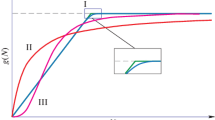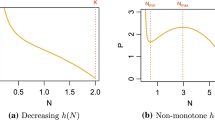Summary
This paper discusses the analysis of selective predation experiments with two types of prey when the prey are not replaced after they have been removed by the predators. In an earlier paper (Manly et al., 1972) consideration was given to situations where the replication of experiments allows the estimation of standard errors from the experimental results; in the present paper a table of standard errors is given for a large range of experiments and replication is therefore no longer necessary. The standard errors were calculated on an electronic computer by solving the exact equations given in the earlier paper.
The suggested method of analysis is illustrated using some data where the prey were red and yellow artificial ‘maggots’ and the predators were garden birds.
Similar content being viewed by others
References
Allen, J. A. andB. Clarke (1968) Evidence for apostatic selection by wild passerines.Nature 220: 501–2.
Clarke, B. C. (1962) Balanced polymorphism and the diversity of sympatric species. InTaxonomy and geography, Ed. byD. Nichols Syst. Ass. Publ. 4: 47–70.
Cook, L. M. (1971)Coefficients of natural selection. Hutchinson London.
Coppinger, R. P. (1969) The effect of experience and novelty on avian feeding behaviour with reference to the evolution of warning coloration in butterflies. Part 1: Reaction of wild caught and adult Blue Jays to novel insects.Behaviour 35: 45–60.
Manly, B. F. J., P. Miller andL. M. Cook (1972) Analysis of a selective predation experiment.Amer. Nat. (accepted for publication).
Mueller, H. C. (1971) Oddity and specific searching image more important than conspicuousness in prey selection.Nature 233: 345–6.
Murton, R.K. (1971) The significance of a specific search image in the feeding behaviour of the Wood-Pigeon.Behaviour 40: 11–42.
O'Donald, P. andC. Pilecki (1970) Polymorphic mimicry and natural selection.Evolution 24: 395–401.
Popham, E. J. (1947) Experimental studies of the biological significance of non-cryptic pigmentation with special reference to insects.Proc. Zool. Soc. Lond. A117: 768–83.
Tinbergen, L. (1960) The natural control of insects in pine woods. 1. Factors influencing the intensity of predation by song birds.Arch. Neer. Zool. 13: 265–343.
Author information
Authors and Affiliations
Rights and permissions
About this article
Cite this article
Manly, B.F.J. Tables for the analysis of selective predation experiments. Res Popul Ecol 14, 74–81 (1972). https://doi.org/10.1007/BF02511186
Issue Date:
DOI: https://doi.org/10.1007/BF02511186




